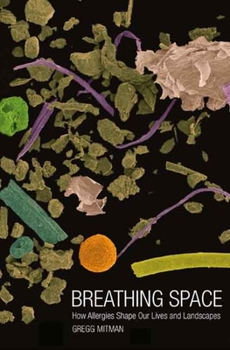Breathing Space: How Allergies Shape Our Lives and Landscapes
Select Format
Select Condition 
Book Overview
Why our efforts to eliminate asthma and hay fever have not just failed but have reshaped American life and spurred the dramatic growth of allergic diseases Allergy is the sixth leading cause of chronic illness in the United States. More than fifty million Americans suffer from allergies, and they spend an estimated $18 billion coping with them. Yet despite advances in biomedicine and enormous investment in research over the past fifty...
Format:Paperback
Language:English
ISBN:030014315X
ISBN13:9780300143157
Release Date:August 2008
Publisher:Yale University Press
Length:336 Pages
Weight:1.10 lbs.
Dimensions:0.7" x 6.0" x 9.3"
Related Subjects
Allergies Biological Sciences Biotechnology Diseases & Physical Ailments Earth Sciences Environmental Science Health Health, Fitness & Dieting Health, Fitness & Dieting Internal Medicine Medical Medical Books Medicine Pulmonary Science Science & Math Science & Scientists Science & TechnologyCustomer Reviews
2 ratings
History of Allery and Asthma treatments 1800-present
Published by Thriftbooks.com User , 16 years ago
This book gave me an appreciation for all of the knowledge that has been accumulated from the 1800s to the present on coping and treating allergies and asthma. The book describes the late 1800s and early 1900s when fortunate allergy sufferers could travel to various locations during pollen season to escape the "hay fever" curse that visited them each year. The book covers: History and background of the treatment of allergies using "allergy shots" in the early 1900s. The benefit of air conditioning had for those fortunate enough to have it in the 1920s and 1930s. Correlations between "cockroaches" and asthma occurance, and "dust mite" feces and allergy occurance in sensitive individuals. Discusses how these links were found by various studies. The introduction of pollen/dust air filters to treat patients who were unable to afford air conditioning. The introduction of antihistimines and inhalers for the treatment of allergies and asthma. The developent of dramamine to treat "sea sickness" and how it was derived from allergy/asthma medicines. As an allergy sufferer, I appreciated learning more about the history of allergy/asthma treatment. This book should be of interest to anyone suffering from allergies or asthma to give them an appreciation of how far we have come in the treatment of these conditions.
God Bless You, America: A Gesundheit to Change the Land
Published by Thriftbooks.com User , 17 years ago
"A low-grade headache, right at the line of my eyes. And a scratchy throat." I whine to my mother on the other end of the line. Throughout Gregg Mitman's Breathing Space: How allergies shape our lives and landscapes, I scoffed the physical weakness of hay fever suffering elitists turned scientists or entrepreneurs or druggists. That is, until today when I was reminded of my own allergy to the mitigated air quality of my town, which is not unlike any other town in the United States: it borders a more "wild" area, is gridded with Bermuda and Kentucky grasses, and finds financial support in a sundry of industries. This town has housing projects and climate-controlled offices and immigrants, both herb and hominid, all ordinary places and spaces and people which Mitman unveils as somehow marginalized by a drive to eradicate that which ails us: allergens. Though he blows plot secrets in the introduction, Mitman's surprises are in his prose and humor, despite the high stakes: that the "increased technological optimism [made] Americans confident in their ability to rid the landscape of allergy" also enabled the population to believe and to consume as if they could create a pristine, non-combative interior landscape, both in their homes and within the bounds of the body (7). These major themes are best played out in the chapters "On the Home Front," a history of the innovations to cleanse our personal and private spaces, "Choking Cities," a stab at the hypocrisy of American indifference to their own inner-city citizens' suffering while sending children from all over the world to high-cost, remote "scratch test centers," both bastions of relief and experiment. Though the theme of environmental justice runs like a nose throughout the book, beginning with a hilarious anecdote on a chain-wielding Mr. T, he takes a stronger critical look at the governmental institutions that enabled the architecture and bureaucracy of interior allergy than other texts in the field. Mitman's ability to synthesize not only the complex political, economic, and social climates but the history of medicine and technology make this text useful for pre-med and post-medicated people alike. An undergraduate course might find specific chapters useful for grounding what is now the post-modern perspective: there is no outside. As an ecology student, I longed for more extensive histories on plants, production, and a kind of Pollanesque perspective, as well as denser chemical discussion in lieu of drawn out stories of obscure poets sniffling. Also, the rhetorical links of ragweed, also called "river-rat" and "slum dweller," to less-desirable human populations, as Peter Coates has made opaque, seemed under utilized (55). Still, Mitman's collection of images, affection for irony and overwhelming knowledge of medicine legitimate this book as a supporter of what is most important: "the evolving relationship of body and place" (250). So change your AC filters, pop a non-drowsy Claritin (thou






